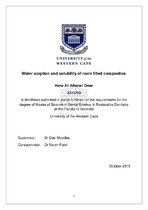| dc.description.abstract | Resin filled dental composite materials has been introduced into dental practice since mid-1960s as an aesthetic restorative material for anterior teeth (Bowen, 1962 cited in Peutzfeldt, 1997). Since then, they have undergone several developments in order to enhance the longevity and performance of these materials. Resin filled dental composites consist of three main components namely, organic resin matrix which consists of a monomer, an initiator system and a stabilizer system, inorganic filler such as quartz, silica, etc. and coupling agent such as organo-silane coupling agent that chemically bonds the inorganic fillers to the organic resin matrix (Phillips, 1973). The properties and the performance of the resin filled dental composites are basically dependent upon the components of the materials. Some properties are related to the resin matrix, whereas others are related to the inorganic fillers and coupling agent. Furthermore, properties such as polymerization shrinkage and water sorption are dependent on both the inorganic fillers and the organic resin matrix (Asmussen, 1975; Hashinger and Fairhust, 1984; Munksgaard et al., 1987). Aim and objectives: The aim and the objectives of this study was to compare the water sorption and solubility of four bulk-fill dental resin composite materials namely, two conventional viscosity bulk-fill (Surefil bulk fill composite and Tetric N Ceram Bulk Fill) and two low viscosity bulk-fill flowable dental composite materials (Filtek Bulk Fill flowable restorative and Surefil SDR Flow). Materials and methods: Four types of bulk-fill composite restorative materials (2 bulk-fill conventional viscosity (Surefil bulk fill composite and Tetric N Ceram Bulk Fill) and 2 bulk-fill flowable low viscosity (Filtek Bulk Fill flowable restorative and Surefil SDR Flow) were used to analyse the water sorption and solubility for each resin composite type. Thirty specimens for each type of material were prepared, giving the total number of specimens to be 120 (n=120). To standardize this study Vita shade A2 was used for all the material types. All specimens were prepared in a Teflon mould with internal diameter of 15±1mm and thickness of 1±0.1mm in accordance with ISO 4049. The light curing unit used for all specimens was Elipar™ S10, (3M ESPE, Germany) at
an output of 1200 mW/cm2 and used according to the manufacturer’s instructions. Prior to curing, the intensity of the light was checked using Cure Rite visible curing light meter (Caulk, USA) to ensure light output consistency between specimens and was found to be 1200 mW/cm2 . All the specimens were first removed from the Teflon mould as prepared and described previously and placed in an oven at 37 ºC until their weights were constant and these weights were recorded as m1 by using an analytic balance (OHAUS, TS400D, USA). Ten specimens of each type of resin filled composite were then immersed individually in glass containers filled with 10 ml distilled water and placed in the oven at 37±1 ºC for 24 hours, 7 days, 14 days respectively. The specimens were removed; surface water was blotted with tissue paper until free from visible moisture and weighed using the analytic balance (OHAUS, TS400D, USA). The resultant weights were recorded as m2. The specimens were then placed in a desiccator containing silica gel (Associated Chemical Enterprises, ZA) and freshly dried for two hours in an oven at 58 ºC and then weighted to obtain m3. According to Oysaed and Ruyter formula (Oysaed and Ruyter, 1986), the water sorption and solubility was calculated using the following equation: i.Water sorption (SP) = m2 -m3 / v., ii.Water solubility (SI) = m1 -m3 / v - where v is the volume of the specimen. For monomer leakage high performance liquid chromatography (HPLC) was used to identify monomers. The water that contained stored specimens was transferred to a refrigerator immediately after the specimens were removed until HPLC analysis was carried out to determine the amount of monomers that leached out of the cured composite specimens. Results: A significant difference between the materials (p<0.05, ANOVA Analysis of Variance) showed that Surefil SDR Flow composite had the lowest overall mean water sorption values (10.191) over the three time intervals (24 hrs, 7 days and 14 days) which was significantly smaller than the other means, followed by Filtek Bulk Fill flowable restorative composite (11.135) and Tetric N Ceram Bulk Fill composite (16.419). The highest water sorption mean value was recorded for Surefil bulk fill composite (21.515). The overall means of water solubility for the two bulk-fill flowables i.e. Filtek Bulk Fill flowable restorative and Surefil SDR Flow were smaller than bulk-fill conventional viscosity Surefil bulk fill and Tetric N Ceram Bulk Fill. However, all the test materials displayed no statistically significant increase in water solubility over the time period (p > 0.05 two way ANOVA test). The amounts of eluted monomers from bulk-fill conventional viscosity materials (Surefil bulk fill and Tetric N Ceram Bulk Fill) were higher than bulk-fill flowable materials (Surefil SDR Flow and Filtek Bulk Fill flowable restorative). Of all the monomers tested UDMA eluted more than Bis-GMA and TEGDMA. Overall UDMA monomer eluted the most, followed by Bis-GMA and the TEGDMA. Conclusion: Within the limitation of this study, the results of this study did not support the null hypothesis that there is no significant difference in the water sorption. The bulk-fill low viscosity flowables showed lower water sorption than the conventional viscosity bulk-fills. Surefil SDR Flow was significantly lower than the other materials followed by Filtek Bulk Fill flowable restorative and Tetric N-Ceram Bulk Fill and the highest overall means were recorded for Surefil bulk fill. For water solubility the overall means for the flowables of Filtek and SDR were smaller than Surefil and Tetric N-Ceram. For monomer elution three monomers were detected of which UDMA monomer eluted the most, followed by Bis-GMA and the TEGDMA. With regards to the elution of monomers, it was found that 3 monomers named UDMA eluted more than Bis-GMA and TEGDMA. | en_US |

